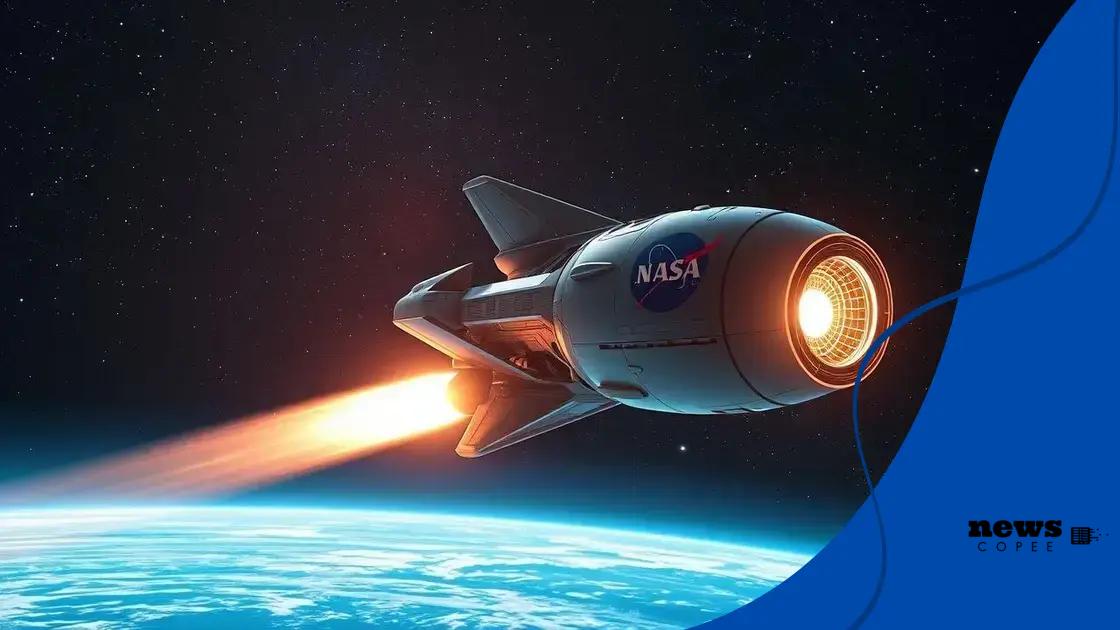NASA confirms missions for 2025: what to expect

NASA’s upcoming missions for 2025 aim to enhance our understanding of space through exploration of Mars, the Moon, and advancements in technology, while fostering international collaboration and inspiring future generations.
NASA confirms missions for 2025 with a lineup of groundbreaking projects that promise to redefine our understanding of the universe. Are you ready to explore what’s ahead in space exploration?
Overview of NASA’s upcoming missions
As we dive into the overview of NASA’s upcoming missions, it’s exciting to see how they plan to explore new frontiers in space. These missions will not only advance our knowledge but also push the boundaries of technology and international collaboration.
Mars Exploration Missions
One significant aspect of the 2025 missions includes renewed efforts to explore Mars. NASA aims to send robotic missions to gather samples and analyze the planet’s surface. Scientists are eager to discover potential signs of past life and understand Mars’s climate better.
Artemis Program
Another critical initiative is the Artemis program, which aims to return humans to the Moon by the end of the decade. In 2025, NASA plans to launch Artemis III, which will land astronauts on the lunar South Pole. This mission will pave the way for future lunar exploration and help establish a sustainable presence on the Moon.
- Focus on scientific research and lunar habitation.
- Preparations for Mars missions.
- Collaboration with international space agencies.
Not only will these missions enhance our lunar understanding, but they will also serve as a launching pad for future missions to Mars. The technology developed through the Artemis program will be crucial for long-duration space travel. Additionally, NASA is prioritizing sustainability during these missions, ensuring that they minimize environmental impact while maximizing scientific gain.
Technological Innovations
NASA’s upcoming missions will incorporate cutting-edge technology that enhances spacecraft design and mission efficiency. Innovations such as advanced propulsion systems and AI-powered systems will improve operational capabilities. These technologies are essential for ensuring the safety of astronauts and the success of complex missions.
Global Partnerships
Finally, partnerships with international space organizations are more prominent than ever. These collaborations will facilitate knowledge sharing and resource pooling, creating a more robust approach to space exploration. Through these alliances, NASA aims to engage more countries in the quest for discovery.
Key discoveries expected in 2025
Exploring space has always held the promise of remarkable discoveries, and in 2025, NASA aims to achieve groundbreaking milestones. The key discoveries expected in 2025 revolve around advancements in our understanding of planets, moons, and potentially extraterrestrial life.
New Insights into Mars
One of the primary focuses is Mars, where upcoming missions will investigate the planet’s history. Scientists are specifically interested in understanding the water history on Mars and assessing whether conditions might have supported life in the past.
- Analyzing Martian soil samples for microbial life.
- Studying the geology related to ancient water sources.
- Mapping potential sites for future human exploration.
This research could change our view of the Red Planet, opening doors for future expeditions and possible habitation.
Exploring the Lunar South Pole
The lunar South Pole is another area ripe for discovery. It is believed to contain water ice, which could be crucial for future human missions. The Artemis program will investigate these regions more closely, providing insight into the Moon’s geological activity.
Understanding the Moon’s resources is vital for establishing a permanent presence there. This involves examining the composition of the soil and evaluating how these resources can support human life.
Exoplanet Studies
Additionally, NASA’s focus on exoplanets will lead to exciting findings. Using advanced telescopes, scientists will search for Earth-like planets in habitable zones around their stars. These investigations will enhance our knowledge of the universe and the potential for life beyond Earth.
With improved technology, astronomers hope to directly observe atmospheres and search for signs of biological activity. This could be a pivotal moment for understanding our place in the universe.
Technological Advances in Space Exploration
Along with these discoveries, technological advancements will play a crucial role in achieving mission goals. Innovations in robotics and AI will enhance data collection, allowing missions to operate more efficiently and prolonging their duration in space.
Through these efforts, NASA is preparing for a future where exploration is not just about visiting new places but truly understanding them. Each mission’s findings will contribute valuable knowledge to our collective understanding of space.
Technology advancements for space travel

The future of space travel relies heavily on technological advancements. As NASA prepares for ambitious missions in 2025, innovative technologies are essential for ensuring safety and success in deep space exploration.
Revolutionary Propulsion Systems
One of the key areas of focus is improving propulsion systems. New technologies, like ion propulsion and Nuclear Thermal Propulsion, allow spacecraft to travel faster and more efficiently. These advancements can significantly reduce travel time to distant destinations, such as Mars.
- Increased fuel efficiency.
- Longer mission durations.
- Decreased time between launches.
The implications of these systems extend beyond just speed; they can also support more complex missions, potentially carrying more scientific equipment and crew.
Advanced Robotics
Robotics also plays a crucial role in future missions. NASA is integrating smart robots for exploration and maintenance tasks. These robots can operate in harsh environments, collect data, and even assist astronauts during missions.
The automation and efficiency of these robots allow for deeper exploration without putting human lives at risk. By employing cutting-edge technology, NASA aims to enhance both the safety and effectiveness of its missions.
Artificial Intelligence Applications
Artificial Intelligence (AI) is transforming how NASA conducts missions. AI can analyze vast amounts of data in real-time, helping scientists make faster decisions about experiments and exploration strategies.
Device monitoring and predictive maintenance will become easier, allowing more extended missions with less risk of equipment failure. AI technology also enables autonomous navigation, which is particularly useful on distant planets where real-time communication with Earth is challenging.
Innovative Life Support Systems
The development of innovative life support systems is another significant advancement. Future missions must sustain human life for long durations, which includes recycling air and water and growing food in space.
These systems will ensure the health and well-being of astronauts on long missions, like going to Mars. Sustainable life support technology is vital for supporting human presence beyond Earth’s orbit.
International collaboration on space projects
International collaboration on space projects is more crucial than ever, especially as NASA prepares for its ambitious plans for 2025. Working together with other countries allows for shared resources and expertise, leading to more successful missions.
Global Partnerships
Nations around the world are coming together to tackle the challenges of space exploration. Countries like Canada, Japan, and member states of the European Space Agency collaborate with NASA on various missions. This teamwork combines technology, funding, and knowledge.
- Joint missions to the Moon and Mars.
- Sharing scientific data and research.
- Developing new technologies together.
This merging of talents helps to advance our understanding of space more rapidly than any one nation could do alone.
Commercial Space Ventures
In addition to traditional collaborations, private companies are also entering the scene. NASA is increasingly partnering with commercial space ventures, which brings fresh ideas and innovation to space projects.
These collaborations include launching satellites, developing spacecraft, and supporting missions to the International Space Station (ISS). It opens new pathways for exploration, making space more accessible to more countries.
Shared Resources and Knowledge
International collaboration allows for the sharing of financial and research resources. For example, joint missions to the Moon will utilize technologies developed by multiple nations, creating a more effective approach to lunar exploration.
Through knowledge sharing, scientists can improve upon each other’s findings and accelerate the pace of discovery. This synergy fosters a global scientific community that benefits everyone.
Addressing Global Challenges
As nations collaborate on space projects, they also tackle global challenges like climate change. Satellites launched by international teams provide crucial data for monitoring Earth’s health.
Space missions can lead to advancements in technology that directly impact life on Earth, such as disaster response and environmental protection.
Impact of missions on future exploration
The impact of missions on future exploration is a crucial topic as we look forward to NASA’s plans for 2025. Each space mission provides valuable data that shapes our understanding of the cosmos and influences future endeavors.
Advancements in Scientific Knowledge
Every mission carries the potential to uncover new scientific knowledge. For instance, missions to Mars could provide insights into the planet’s geology and climate. Understanding these factors allows scientists to develop better models for planetary development.
- Discovering the presence of water ice on Mars.
- Identifying potential for past life.
- Studying climate patterns on other planets.
This knowledge not only enhances our understanding of Mars but can also inform the search for life on other planets.
Technological Innovations
Space missions also drive technological innovation. The challenges faced during exploration often lead to breakthroughs in various fields, including robotics, materials science, and communications technology.
For example, advancements developed for space travel often find applications on Earth, improving everyday technologies such as satellite communications and medical devices. The technology created for exploring the Moon will benefit future Mars missions, making them safer and more efficient.
Inspiration for Future Generations
Space missions inspire new generations of scientists, engineers, and dreamers. As people witness powerful images and stories from space exploration, they become motivated to pursue careers in science and technology. This inspiration is crucial for fostering a skilled workforce that will tackle future challenges.
By engaging in educational outreach, NASA and other organizations can ensure that the excitement of exploration influences young minds, encouraging them to contribute to the future of space travel.
Global Cooperation
International collaborations during missions also set a precedent for future exploration. These partnerships foster a sense of unity among nations. When countries work together, they share knowledge and resources, which can result in more ambitious projects that no single nation could achieve alone.
Successful international missions pave the way for cooperative efforts, such as joint explorations of asteroids or deeper space exploration, reinforcing the idea that collaboration can lead to greater discoveries.
FAQ – Frequently Asked Questions about NASA’s Upcoming Missions
What are the main goals of NASA’s 2025 missions?
The main goals include exploring Mars, returning humans to the Moon, and advancing our understanding of exoplanets.
How do international collaborations benefit space missions?
International collaborations allow countries to share resources, expertise, and technology, enhancing the success of missions.
What technological advancements are expected from these missions?
Technological advancements may include improved propulsion systems, AI applications, and new life support systems that can sustain astronauts.
Why is inspiring future generations important for space exploration?
Inspiring future generations encourages young people to pursue careers in science and technology, which is crucial for the future of space exploration.
